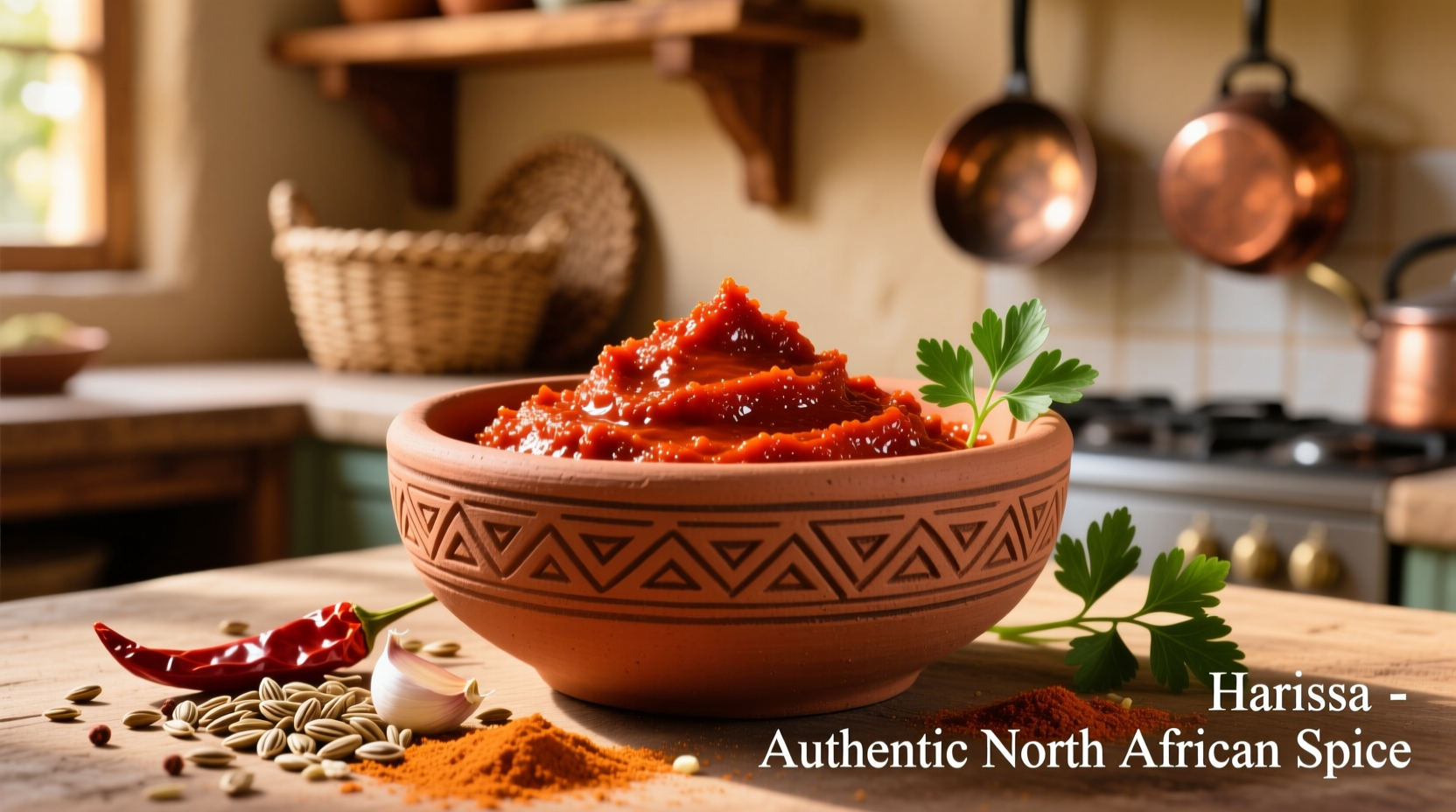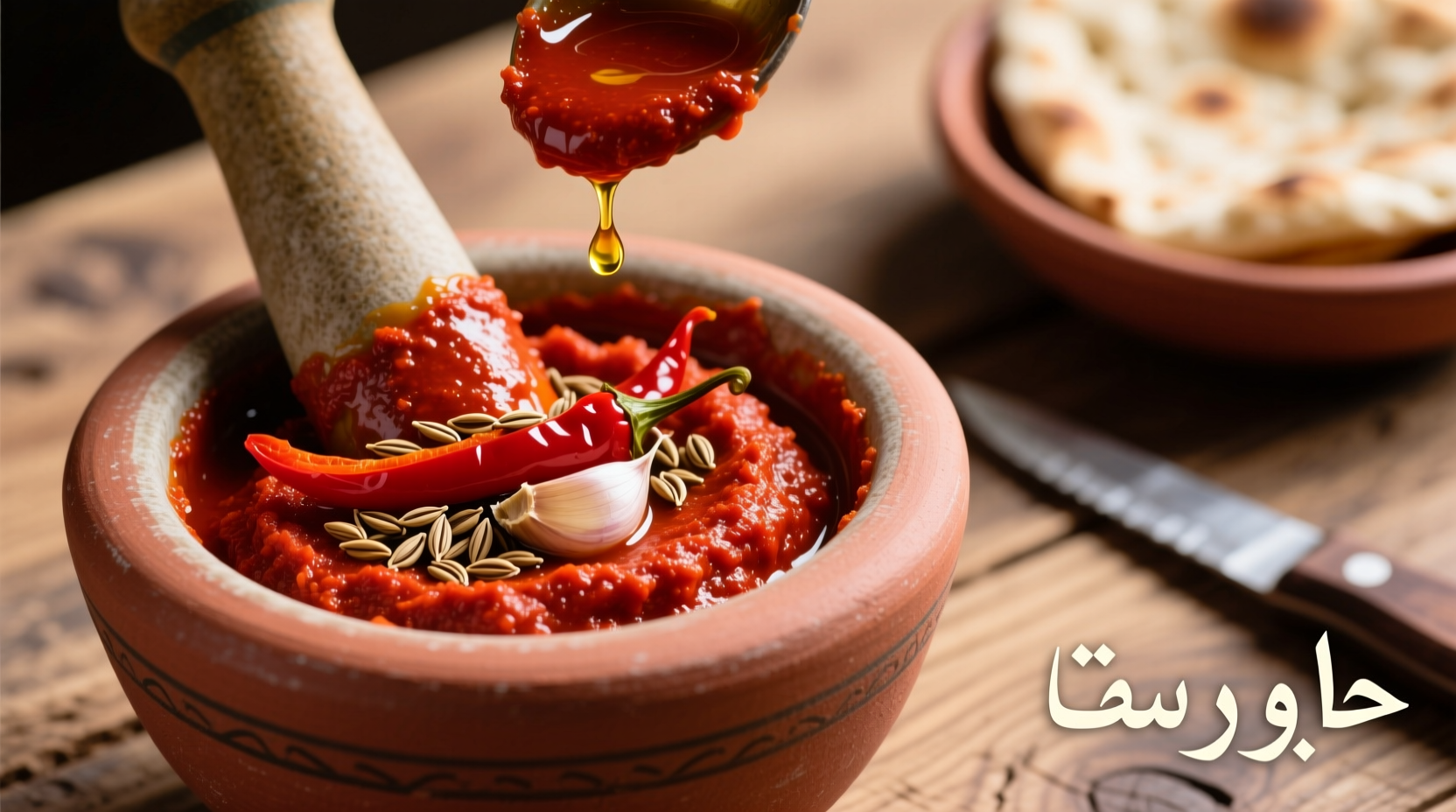Ever wondered what gives North African cuisine its distinctive fiery character? Harissa, the vibrant chili paste originating from Tunisia, offers far more than just heat. Understanding its nuanced flavor profile transforms how you use this versatile condiment in your cooking.
Breaking Down Harissa's Flavor Components
Harissa isn't simply "spicy"—it's a sophisticated blend where multiple flavor elements work in harmony. The base of traditional harissa consists of roasted red peppers (typically Baklouti peppers), which provide:
- Smokiness from roasted peppers and sometimes smoked paprika
- Medium heat that builds gradually (2,500-5,000 Scoville units)
- Tanginess from added citrus or vinegar
- Earthy depth from cumin and coriander
- Garlicky pungency that mellows when cooked
- Subtle sweetness balancing the heat
Unlike many Western hot sauces that emphasize vinegar punch, authentic harissa relies on roasted pepper flavor as its foundation. The heat level varies significantly based on pepper variety and preparation method—freshly made harissa tends to have brighter, more complex heat than commercial versions.
Regional Variations That Shape Harissa's Taste
Harissa's flavor profile shifts dramatically across North Africa, reflecting local ingredients and traditions. This culinary evolution timeline shows how regional differences developed:
| Region | Key Flavor Characteristics | Distinguishing Ingredients |
|---|---|---|
| Tunisia (origin) | Bright, citrus-forward, moderate heat | Garlic, caraway, lemon juice |
| Morocco | Smokier, earthier, less acidic | Ras el hanout spices, rose petals |
| Algeria | Hotter, oilier texture | Extra olive oil, minimal citrus |
| Libya | Sweet-spicy balance, tomato-forward | Tomato paste, less garlic |
According to culinary anthropologists at the University of Tunis, harissa evolved from Berber cooking traditions where preserved peppers provided essential nutrients during winter months. The addition of garlic and spices created not just flavor but natural preservation—explaining why authentic harissa maintains quality for months when properly stored.
Harissa vs. Other Chili Pastes: A Flavor Comparison
Understanding how harissa differs from similar condiments helps you choose the right one for your dish. This comparison clarifies key distinctions:
| Condiment | Heat Level | Primary Flavor Notes | Best Culinary Applications |
|---|---|---|---|
| Traditional Harissa | Moderate (builds gradually) | Smoky, earthy, citrusy | Stews, marinades, roasted vegetables |
| Sriracha | Medium-high (immediate) | Vinegary, sweet, garlicky | Dipping sauces, stir-fries, sandwiches |
| Gochujang | Mild to medium (complex) | Sweet, fermented, umami | Glazes, braises, Korean dishes |
| Chili Garlic Sauce | High (sharp) | Raw garlic, vinegar punch | Quick flavor boosts, Asian dishes |
Food scientists at the Culinary Institute of America note that harissa's unique flavor development comes from the Maillard reaction during pepper roasting, creating complex flavor compounds absent in raw-chili condiments. This explains why harissa adds depth rather than just heat to dishes.
When Harissa Works Best (and When to Choose Alternatives)
Harissa shines in specific culinary contexts but has limitations. Understanding these boundaries prevents flavor mismatches:
Ideal applications:
- As a base for tagines and stews (adds depth during slow cooking)
- Marinating proteins (especially lamb, chicken, and fish)
- Enhancing roasted vegetables (carrots, cauliflower, sweet potatoes)
- Mixing with yogurt or mayo for creamy sauces
- Stirring into grain dishes like couscous or quinoa
Limited effectiveness:
- Cold dishes where raw garlic flavor dominates
- Desserts or sweet applications
- Fish dishes requiring delicate flavor profiles
- When immediate, sharp heat is desired
Chef Mourad Lahlou, James Beard Award-winning expert in North African cuisine, explains: "Harissa needs time to mellow and integrate with other ingredients. Unlike vinegar-based hot sauces that provide instant punch, harissa's magic happens when its flavors bloom through cooking."
Practical Tips for Selecting and Using Harissa
Not all harissa delivers the authentic flavor experience. Follow these guidelines to maximize flavor impact:
Reading Labels Like a Pro
Quality commercial harissa should list:
- Roasted red peppers as the first ingredient
- Minimal additives (no corn syrup or artificial colors)
- Olive oil rather than cheaper vegetable oils
- Whole spices rather than generic "spice blend"
Flavor Enhancement Techniques
Professional chefs use these methods to unlock harissa's full potential:
- Bloom in oil: Cook 1-2 teaspoons in olive oil for 30 seconds before adding liquids
- Balance acidity: Add lemon juice or vinegar to brighten flavors
- Sweeten subtly: A pinch of honey counters excessive heat
- Dilute properly: Mix with yogurt or tahini for sauces

Storage Matters
Proper storage preserves harissa's delicate flavor balance. Keep homemade versions in airtight containers with a thin layer of olive oil on top—this creates a barrier against oxidation. Commercial versions maintain best flavor for 3-4 weeks after opening when refrigerated. Freezing in ice cube trays allows portion control for future recipes.
Bringing Harissa's Flavor to Your Kitchen
Understanding harissa's complex flavor profile transforms it from a simple hot sauce into a versatile culinary tool. When selecting or making harissa, prioritize products where the roasted pepper flavor shines through rather than overwhelming heat. Remember that authentic harissa should complement dishes rather than dominate them—its magic lies in how it enhances other ingredients through its balanced flavor profile.
Whether you're stirring it into soups, using it as a marinade base, or mixing it with creamy elements for sauces, recognizing harissa's distinctive taste characteristics ensures you use it effectively. This knowledge bridges the gap between simply adding heat and creating genuinely layered, authentic North African-inspired flavors in your cooking.











 浙公网安备
33010002000092号
浙公网安备
33010002000092号 浙B2-20120091-4
浙B2-20120091-4